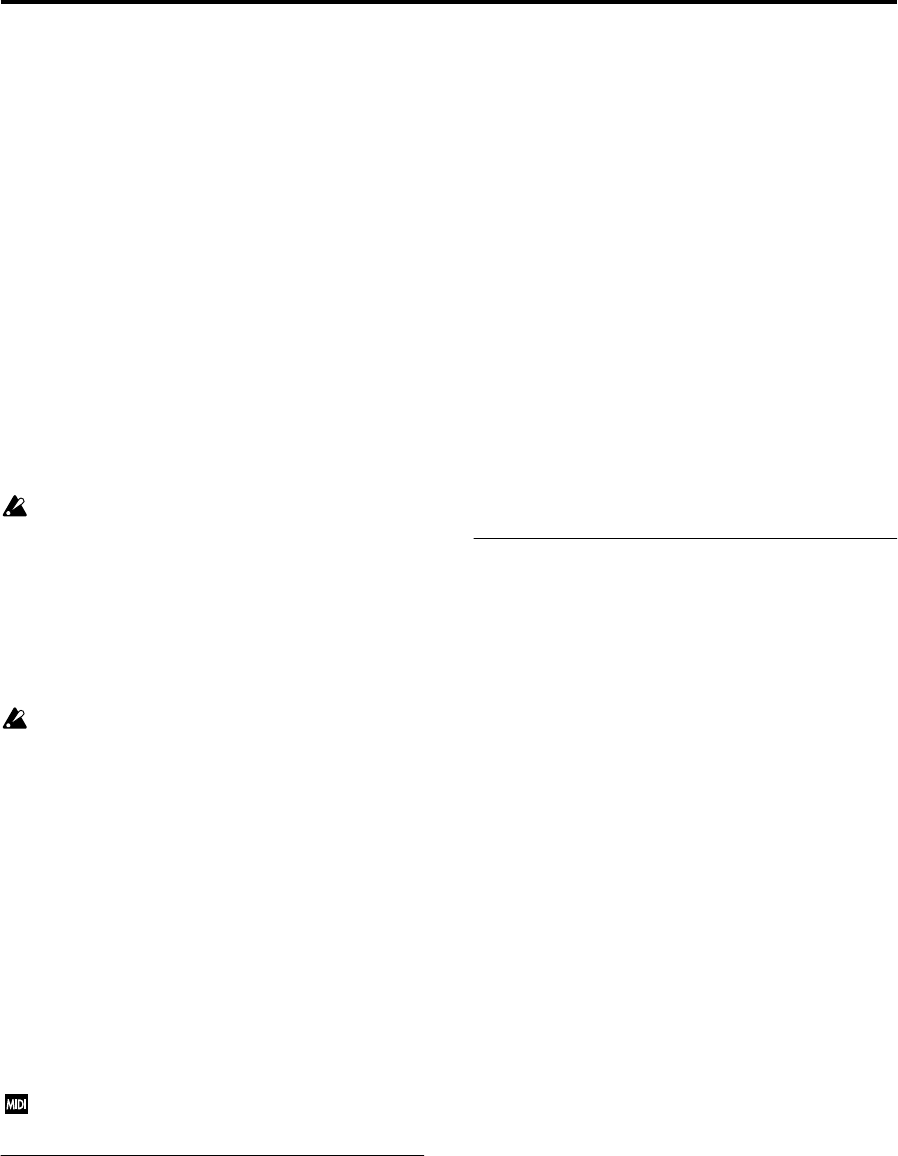
PROG P6: Vocoder 6–1: Carrier/Modulator
43
AUX Send L+R: The mono-mixed signal of AUX buses 1+2
or 3+4 specified by Audio Inputs (Send to RADIAS).
AUX Send L: The signal of AUX bus 1 or 3.
AUX Send R: The signal of AUX bus 2 or 4.
Gate S7ens (Gate Sensitivity) [000…127]
Specifies how fast the gate will respond to the input source.
Decreasing this setting will make the gate respond more
quickly, and the vocoder sound will decay faster.
Increasing this setting will make the gate operate more
slowly, and the vocoder sound will have a longer decay.
Note: Gate operation is affected by the Threshold setting.
The effect will be more apparent if the Threshold value is
high, and there will be no effect if the value is zero.
Threshold [000…127]
Sets the level at which the input source will be cut.
By setting this to an appropriate level you can cut the noise
that might be present during times of no input.
Higher settings will make it more likely that the input
source will be cut.
With excessively high settings, there will be more
chance that the audio input signal itself will be cut,
making it difficult for you to apply the vocoder effect as
intended.
Select (Formant Motion Select)
[Formant Motion 00…Formant Motion 16]
Selects the formant motion data.
This is available for editing only if Modulator is set to
Formant Motion.
If you select other formant motion data without
writing, any formant motion data you had been editing
will be lost. (☞ “Writing formant motion data” on
page 14)
Note: If you use the “To” field of the dialog box to change
the data number when writing formant data, the Formant
will also change to the number you specified in the dialog
box. (☞ “Writing formant motion data” on page 14)
Play Mode (Formant Motion Play Mode)
[Free Run, Trigger Reset]
Specifies how the formant motion data will be played back.
This is shown and can be edited if Modulator is set to
Formant Motion.
Free Run: The formant motion data will play as a loop from
the beginning to the end.
Trigger Reset: The formant motion data will play from the
beginning to the end each time you press a note.
The formant motion data can be triggered by the Global
MIDI channel.
6–1d: Out Mix
Vocoder Output Level [000…127]
Sets the output level of the vocoder.
Modulator Direct Mix [000…127]
Sets the volume level at which the modulator input source
will be output directly (unaffected).
Modulator HPF Gate [Disable, Enable]
If the high-frequency portion of the modulator is mixed into
the output of the vocoder, this setting specifies whether this
high-frequency portion will be output only while the
internal sound generator is producing sound, or be output
whenever there is an input to Source.
Disable: Even when the internal sound generator is not
producing sound, the audio source being input to the
modulator will be mixed into the output. For example if
you’re using a guitar connected to the AUDIO INPUT 1 jack
as the carrier, you can use this setting so that the vocoder
will be applied at all times even when you’re not playing the
keyboard. The input source to the modulator will always be
output.
Enable: The audio source being input to the modulator will
be mixed into the output only when the internal sound
generator is producing sound. Normally, you will choose
this setting if you’re applying the vocoder to the internal
sound generator being played from the keyboard, or if the
output of an external synthesizer etc. connected to the
AUDIO INPUT 1 jack is being input to the carrier, mixed
with the internal sound generator, and processed by the
vocoder.
Modulator High Mix [000…127]
Sets the level at which the high-frequency components of
the input source will be mixed into the output of the
vocoder. Higher settings will emphasize the consonants in
your voice.
▼6–1: Menu Command
• Write Formant Motion Data ☞p.46
• Copy Vocoder ☞p.46


















